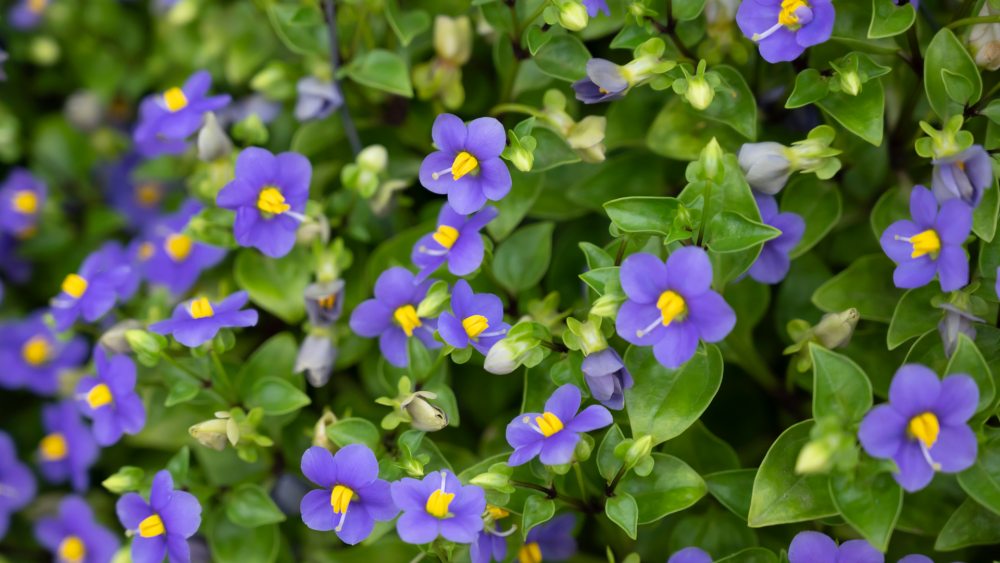
Exacum, often known as the Persian violet, is a stunning flowering houseplant that can add a splash of color and a touch of elegance to any room. Known for its vibrant, violet-like blooms and glossy, dark green foliage, Exacum is a great choice for plant enthusiasts who want a flowering indoor plant. Though it’s relatively easy to care for, Exacum does have specific needs that must be met to keep it healthy and blooming. Here’s everything you need to know about caring for Exacum.
Exacum plants thrive in bright, indirect light. They need plenty of light to encourage blooming, but direct sunlight can scorch their delicate leaves. A spot near a bright window that doesn’t get harsh afternoon sun is ideal. If you don’t have a naturally bright space, Exacum can also do well under artificial grow lights. Keep in mind that insufficient light can cause the plant to become leggy and reduce the number of flowers.
Exacum has relatively high water needs, but it’s important to avoid overwatering. Water the plant thoroughly when the top inch of soil feels dry, but ensure the pot has good drainage to prevent water from sitting at the bottom. Standing water can lead to root rot. During the growing season (spring and summer), Exacum may need more frequent watering, but in the winter, you can cut back on watering as the plant enters a dormant period. Always check the soil moisture before watering to avoid waterlogging.
Exacum enjoys moderate to high humidity. It’s a good idea to place the plant in a more humid area of your home, such as the bathroom or kitchen, where humidity levels tend to be higher. If the air in your home is dry, especially during winter, you can increase humidity by placing the plant on a humidity tray filled with water and pebbles or by using a humidifier. Regular misting can also help, but be sure not to overdo it, as excessive moisture on the leaves can lead to fungal issues.
Exacum prefers well-draining, slightly acidic to neutral soil. A high-quality potting mix works well, but adding some perlite or sand can improve drainage and prevent the soil from becoming too compacted. Make sure the pot has drainage holes to allow excess water to drain. Exacum plants don’t like to sit in soggy soil, so proper drainage is key to keeping the roots healthy.
Exacum thrives in moderate temperatures, typically between 60-75°F (15-24°C). They do not tolerate cold temperatures well, so avoid placing them in areas with drafts or near air conditioners. Keep the plant away from cold windows during winter, as exposure to cold temperatures can cause the plant to wilt or stop blooming. Maintaining a consistent, warm environment will help your Exacum stay healthy and continue flowering.
During the growing season (spring and summer), Exacum benefits from regular feeding to encourage blooms. Use a balanced, water-soluble fertilizer diluted to half strength and apply once every 4-6 weeks. Avoid over-fertilizing, as this can lead to excessive leaf growth at the expense of flowers. In the fall and winter, when the plant is not actively growing, reduce or stop fertilizing altogether.
Exacum doesn’t require heavy pruning, but you can remove spent flowers to encourage new blooms and keep the plant looking tidy. If the plant becomes leggy or overgrown, you can trim back the stems to maintain its shape. Always use clean, sharp scissors or pruning shears to avoid damaging the plant. Regular deadheading (removing faded flowers) is especially important for Exacum, as it helps to prolong the blooming period.
Exacum doesn’t need frequent repotting, but it’s a good idea to refresh the soil every couple of years or when the plant becomes root-bound. Choose a pot that is just slightly larger than the current one to avoid overpotting, which can lead to excess moisture in the soil. Repotting is best done in the spring, just before the growing season begins. Be sure to gently loosen the roots and remove any dead or damaged ones before placing the plant in fresh soil.
Exacum is non-toxic to pets, making it a safe choice for homes with cats, dogs, or other animals. While the plant itself is not harmful, it’s still a good idea to keep it out of reach of pets that may be tempted to nibble on the leaves. If your pet does ingest any part of the plant, it’s unlikely to cause serious harm, but it’s always best to monitor for any signs of gastrointestinal upset and contact your vet if needed.